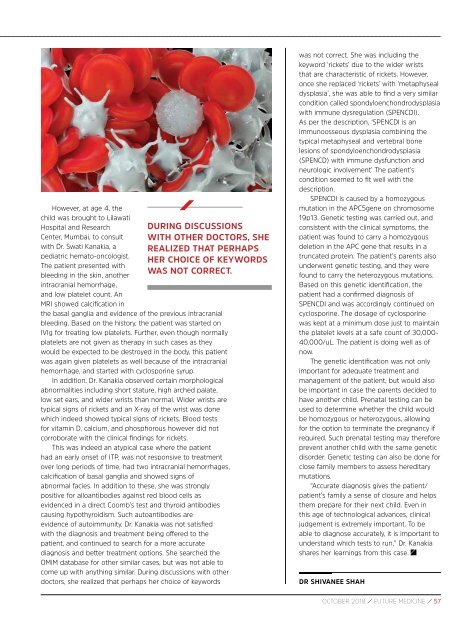You also want an ePaper? Increase the reach of your titles
YUMPU automatically turns print PDFs into web optimized ePapers that Google loves.
However, at age 4, the<br />
child was brought to Lilawati<br />
Hospital and Research DURING DISCUSSIONS<br />
Center, Mumbai, to consult WITH OTHER DOCTORS, SHE<br />
with Dr. Swati Kanakia, a REALIZED THAT PERHAPS<br />
pediatric hemato-oncologist.<br />
HER CHOICE OF KEYWORDS<br />
The patient presented with<br />
WAS NOT CORRECT.<br />
bleeding in the skin, another<br />
intracranial hemorrhage,<br />
and low platelet count. An<br />
MRI showed calcification in<br />
the basal ganglia and evidence of the previous intracranial<br />
bleeding. Based on the history, the patient was started on<br />
IVIg for treating low platelets. Further, even though normally<br />
platelets are not given as therapy in such cases as they<br />
would be expected to be destroyed in the body, this patient<br />
was again given platelets as well because of the intracranial<br />
hemorrhage, and started with cyclosporine syrup.<br />
In addition, Dr. Kanakia observed certain morphological<br />
abnormalities including short stature, high arched palate,<br />
low set ears, and wider wrists than normal. Wider wrists are<br />
typical signs of rickets and an X-ray of the wrist was done<br />
which indeed showed typical signs of rickets. Blood tests<br />
for vitamin D, calcium, and phosphorous however did not<br />
corroborate with the clinical findings for rickets.<br />
This was indeed an atypical case where the patient<br />
had an early onset of ITP, was not responsive to treatment<br />
over long periods of time, had two intracranial hemorrhages,<br />
calcification of basal ganglia and showed signs of<br />
abnormal facies. In addition to these, she was strongly<br />
positive for alloantibodies against red blood cells as<br />
evidenced in a direct Coomb’s test and thyroid antibodies<br />
causing hypothyroidism. Such autoantibodies are<br />
evidence of autoimmunity. Dr. Kanakia was not satisfied<br />
with the diagnosis and treatment being offered to the<br />
patient, and continued to search for a more accurate<br />
diagnosis and better treatment options. She searched the<br />
OMiM database for other similar cases, but was not able to<br />
come up with anything similar. During discussions with other<br />
doctors, she realized that perhaps her choice of keywords<br />
was not correct. She was including the<br />
keyword ‘rickets’ due to the wider wrists<br />
that are characteristic of rickets. However,<br />
once she replaced ‘rickets’ with ‘metaphyseal<br />
dysplasia’, she was able to find a very similar<br />
condition called spondyloenchondrodysplasia<br />
with immune dysregulation (SPENCDI).<br />
As per the description, ‘SPENCDI is an<br />
immunoosseous dysplasia combining the<br />
typical metaphyseal and vertebral bone<br />
lesions of spondyloenchondrodysplasia<br />
(SPENCD) with immune dysfunction and<br />
neurologic involvement’ The patient’s<br />
condition seemed to fit well with the<br />
description.<br />
SPENCDI is caused by a homozygous<br />
mutation in the APC5gene on chromosome<br />
19p13. Genetic testing was carried out, and<br />
consistent with the clinical symptoms, the<br />
patient was found to carry a homozygous<br />
deletion in the APC gene that results in a<br />
truncated protein. The patient’s parents also<br />
underwent genetic testing, and they were<br />
found to carry the heterozygous mutations.<br />
Based on this genetic identification, the<br />
patient had a confirmed diagnosis of<br />
SPENCDI and was accordingly continued on<br />
cyclosporine. The dosage of cyclosporine<br />
was kept at a minimum dose just to maintain<br />
the platelet levels at a safe count of 30,000-<br />
40,000/uL. The patient is doing well as of<br />
now.<br />
The genetic identification was not only<br />
important for adequate treatment and<br />
management of the patient, but would also<br />
be important in case the parents decided to<br />
have another child. Prenatal testing can be<br />
used to determine whether the child would<br />
be homozygous or heterozygous, allowing<br />
for the option to terminate the pregnancy if<br />
required. Such prenatal testing may therefore<br />
prevent another child with the same genetic<br />
disorder. Genetic testing can also be done for<br />
close family members to assess hereditary<br />
mutations.<br />
“Accurate diagnosis gives the patient/<br />
patient’s family a sense of closure and helps<br />
them prepare for their next child. Even in<br />
this age of technological advances, clinical<br />
judgement is extremely important. To be<br />
able to diagnose accurately, it is important to<br />
understand which tests to run,” Dr. Kanakia<br />
shares her learnings from this case.<br />
DR SHIVANEE SHAH<br />
<strong>OCTOBER</strong> <strong>2018</strong> / FUTURE MEDICINE / 57


















